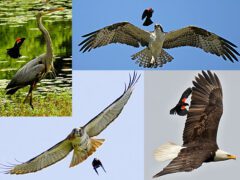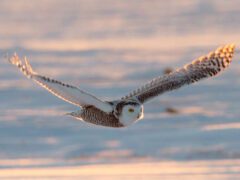Lesser Black-backed Gull Similar Species Comparison
Main SpeciesLesser Black-backed Gull
Breeding adult (graellsii)
A large, dark-backed gull with long wings and yellow legs. Adults show a large red spot on the bill and moderate contrast between the dark gray back and black primaries. In late summer and fall, adults molt their wing feathers—the worn tips to the old, unreplaced outer primaries are visible here.
© Terry Bohling / Macaulay LibraryNew Jersey, September 23, 2020Breeding adult (intermedius)
A large, high-contrast gull with long wings, yellow legs, and a dark gray back; adults show a large red spot on the yellow bill. Subspecies identification is very complicated away from the breeding grounds. The European subspecies intermedius shows dark gray upperparts that are intermediate in shade between the paler birds of northwestern Europe (graellsii) and the black-backed birds from the Baltic Sea and northeastern Europe (fuscus).
© Christoph Moning / Macaulay LibrarySchleswig-Holstein, August 04, 2009Breeding adult (fuscus)
Long wings, yellow legs, and dark upperparts combine to distinguish this adult. Breeding birds from the Baltic Sea and northeastern Europe (fuscus) are truly blackish above rather than slate gray. This is the darkest-backed of all subspecies.
© David Jeffrey Ringer / Macaulay LibraryStockholms län [SE-01], June 23, 2018Breeding adult (Heuglin's)
A long-winged, dark gray-backed gull with yellowish legs. The subspecies found breeding in western Siberia between the Kola and Taimyr peninsula (subspecies heuglini) apparently interbreeds with “Taimyr” Lesser Black-backed Gull (taimyrensis) at the eastern edge of its range. Subspecies identification of Lesser Black-backed Gulls away from each subspecies’ breeding range can be difficult or impossible.
© yann muzika / Macaulay LibraryIbaraki, April 18, 2020First winter
A large but slim, long-winged gull. Young immatures like this 1st-winter bird are pale-headed, crisply checkered dark and white, and usually show a fully black bill through the first winter. The brown, black, and white plumage is relatively cold-toned.
© Jack Parlapiano / Macaulay LibraryNew Mexico, January 18, 2020Juvenile
Large gull with long wings and a slim black bill; juveniles are cold-toned and show dark feathers crisply edged in white on the back and upperwing.
© Caleb Putnam / Macaulay LibraryMichigan, September 05, 2016Nonbreeding adult (graellsii)
A long-winged, yellow-legged gull showing moderate contrast between the slate gray upperwing and black wingtip. Adults show a restricted amount of white near the wingtip and a red spot on the bill, but may also show immature-like black bill markings.
© Thomas Doebel / Macaulay LibraryDelaware, February 10, 2018Juvenile
As juveniles, these slim, long-winged gulls show cold plumage tones and feature an all dark bill, blackish primaries and secondaries, and a dark tail band that contrasts with a whitish rump and tail base. They appear crisply marked with neat, even feather edgings.
© Caleb Putnam / Macaulay LibraryMichigan, September 05, 2016Juvenile
The wings of first cycle birds are dark below and contrast strongly with the pale body. Birds of this age show black bills and whitish bodies marked with dark splotches. Note the leg color—young immatures show pink legs that gradually become yellow after 2–3 years.
© Jay McGowan / Macaulay LibraryNew York, March 21, 2016Nonbreeding adult (graellsii)
A dark-backed gull with yellow legs and a slim white crescent near the tail formed by the tertial tips. Winter adults show dusky streaks on the head. Wing molt often carries into mid-winter, and late-molting adults like this often appear short-winged because of the new, growing outer primary feathers.
© Drew Chaney / Macaulay LibraryVirginia, January 25, 2019Nonbreeding adult (Heuglin's)
As far as large gulls go, this species appears slim due to its both long wings and long legs. Most subspecies (including heuglini, shown here) show moderate contrast between the dark gray upperparts and the black primary tips.
© James Kennerley / Macaulay LibraryDhofar, February 02, 2018Nonbreeding adult (taimyrensis)
Perhaps because of their long distance migrations, these gulls wander widely and can be expected to appear nearly anywhere on the globe. This pale-backed, dark-eyed individual with long fleshy-yellow legs was seen in Nova Scotia and fits the description of Taimyr Gull (subspecies taimyrensis), though identification of large gull taxa so far out of range is usually either speculative or impossible.
© Ken McKenna / Macaulay LibraryNova Scotia, January 05, 2021Second winter
As they repeatedly molt over the course of 3-4 years, these gulls progress from the checkered juvenile plumage to gray-backed, white-bodied adults. This presumed second winter gull shows replaced, gray-toned upperparts and round-tipped primaries. Note the mostly white head and the mostly black bill, which help to distinguish immatures from other immature large gulls.
© Jonah Benningfield / Macaulay LibraryCalifornia, November 19, 2018Second summer
A long-winged, dark-gray backed gull with pale eyes and yellowish legs. Older immatures show a mix of immature and adult plumage and soft parts characteristics. By focusing on the degree of contrast between the plain, adult-like back feathers and the black primary tips, you can judge the relative darkness of the upperparts, and this can help sort through various local large gull options.
© Joshua Glant / Macaulay LibraryWashington, June 23, 2018Second summer
Because of their long distance migrations and extended exposure to sun and abrasion, it’s very important for large gulls to replace their flight feathers each year. In gulls, molt generally starts near the middle of the wing and progresses outward through the primaries. This older immature bird is midway through replacing its primaries - the dark, ragged outer primaries are old, unreplaced feathers, and the four gray feathers with white tips near the middle of the wing are newly replaced inner primaries. With older immature large gulls, the exact gray tone of the plain adult-like back feathers can be very helpful for identification—compare them to the black wingtips to judge the contrast between these feather tracts.
© Daniel Irons / Macaulay LibraryNew Jersey, July 01, 2019Similar SpeciesGreat Black-backed Gull
Breeding adult
Great Black-backed Gulls are larger than Lesser Black-backed Gulls. Adults can also be separated by their darker gray backs and pink (not yellow) legs.
© Evan Lipton / Macaulay LibraryRhode Island, March 21, 2017Similar SpeciesGreat Black-backed Gull
Breeding adult
Adult Great Black-backed Gulls have large white spots on the wingtips than adult Lesser Black-backed Gulls.
© Luke Seitz / Macaulay LibraryMassachusetts, January 01, 2017Similar SpeciesGreat Black-backed Gull
Second winter
The back on second winter Great Black-backed Gulls has more of a calico or variegated pattern than the checkerboard back of Lesser Black-backed Gulls. Also note size and leg color difference.
© Max McCarthy / Macaulay LibraryMassachusetts, April 02, 2017Similar SpeciesGreat Black-backed Gull
First winter
The bill on first winter Great Black-backed is heavier and is pink at the base, whereas Lesser Black-backed have a thinner entirely black bill.
© Nick Pulcinella / Macaulay LibraryPennsylvania, April 04, 2017Similar SpeciesHerring Gull
Nonbreeding adult (American)
Adult Herring Gulls have paler gray backs than adult Lesser Black-backed Gulls. They also have pink legs, not yellow like adult Lesser Black-backed.
© G & B / Macaulay LibraryConnecticut, October 22, 2016Similar SpeciesHerring Gull
Second winter (American)
Second winter Herring Gulls have paler gray feathers coming in on their back than second winter Lesser Black-backed Gulls. Herrings also lack the smudgy black-eyed look of lesser Black-backed Gulls.
© Chris Wood / Macaulay LibraryNew York, November 08, 2015Similar SpeciesHerring Gull
Juvenile (American)
Herring Gulls are larger than Lesser Black-backed Gulls. Juveniles have evenly brown underparts unlike juvenile Lesser Black-backed, which tend to be whiter and more streaked.
© Evan Lipton / Macaulay LibraryMassachusetts, August 06, 2014Compare with Similar Species
Click on an image to compare
Species in This Family
Gulls, Terns, and Skimmers(Order: Charadriiformes, Family: Laridae)
More to Read
Don't miss a thing! Join our email list
The Cornell Lab will send you updates about birds,
birding, and opportunities to help bird conservation.







































